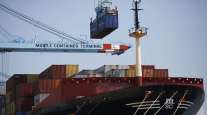Intermodal to Stay Ahead of Economy, Experts Say
This story appears in the May 13 print edition of Transport Topics.
OAK BROOK, Ill. — Intermodal shipments in 2013 should continue growing faster than the economy because of increased shorter haul business, tightening truck capacity and the potential for more cross-border traffic with Mexico, industry experts said.
“Even if the economy struggles a little bit, we will continue to see the growth in intermodal,” said Patrick Casey, vice president of fleet management for Chicago-based TTX Co., speaking at the Intermodal Association of North America’s May 2 Operations and Maintenance Seminar here.
Larry Gross, president of Gross Transportation Consulting in Mahwah, N.J., said a worsening driver shortage and the looming capacity restrictions resulting from the July 1 tightening of hours-of-service rules could trigger volume and rate increases, as more fleets and shippers are forced to shift to intermodal.
IANA is projecting a 4% to 6% volume increase in 2013, according to its quarterly report issued earlier this month. Through the first quarter, North American intermodal shipments rose 4.5% to 3.68 million, including a 6.2% increase in domestic truck-rail moves and a 3% rise in international cargo. That pace continued trends in 2012 and before.
“The economic climate is a little shaky right now,” said TTX’s Casey, whose company is owned by the railroads and supplies pooled equipment for intermodal and other freight. “Though there is a lot to be concerned about, what is encouraging is how well intermodal is doing.”
He noted that intermodal growth continues at twice the pace of gross domestic product, with particular strength in routes where shipments travel less than 1,000 miles, such as the Midwest-Northeast freight corridor.
Shipments on that route now make it the second-largest intermodal corridor, topped only by the Southwest-Midwest route, which is the primary international freight conduit, he said.
The result of the shift to shorter routes has reduced the average intermodal length of haul by close to 10% in the past five years.
Faster train speeds and a 60% increase in the supply of domestic containers have fueled that growth over the same period, Casey said.
“Mexico will become a major part of the market,” he added, after three consecutive years of 22% growth, on average, as more manufacturing fuels cross-border demand.
U.S.-Mexico intermodal ac-counts for 4% to 5% of intermodal cargo between the countries, Casey said. In total, intermodal accounts for more than four of every 10 shipments moving by rail in North America, according to the Association of American Railroads.
Gross said that “we are standing just before what could be viewed as a watershed moment in the trucking industry,” which could swell the shortage of drivers from about 100,000 this year to more than 800,000 within five years because of HOS changes, tougher drug and alcohol rules, credentialing issues and an aging driver corps.
Other sources, such as American Trucking Associations, believe the shortage of drivers is smaller, offering a long-range shortage estimate of about 239,000 by 2022.
“Carriers are going to be much more selective in the freight they choose,” Gross said. “There will be big changes at the loading dock. Shippers will have to keep higher inventory levels.”
Ted Prince, principal of T. Prince & Associates LLC in Richmond, Va., focused on international freight trends, using statistical indicators to show there is no longer a fall peak shipping season.
Prince said international cargo totals through U.S. ports show little quarterly variability in recent years, including 22.2% in the first quarter, 25.6% in the second quarter, 27.6% in the third quarter and 24.6% in the fourth quarter.
“We are seeing a convergence,” he said. “There is no seasonality. Intermodal is becoming a 12-month shipping solution.”
Prince also said the advent of larger ships has changed shipping dynamics.
More East Coast cargo is moving through the Suez Canal, which is 10 days faster from Asia than the Panama Canal. Faced with that time differential, Asian shippers also have stepped up the use of transloading, shifting cargo from international to domestic containers or trailers at warehouses near West Coast ports.
For example, he said, 70% of 45-foot containers moving from Asia to the inland United States are transloaded, compared with 55% in recent years.




